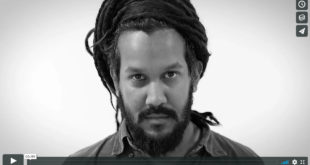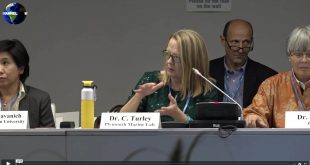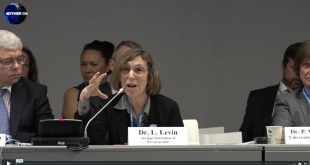Moderator:
Mary Robinson
Panellists:
Christiana Figueres
John Schellnhuber Director
Johan Rockström
Kevin Anderson
#2020 Don’tBeLate seminar sponsored by Mission 2020 and the Leonardo DiCaprio Foundation gave a 90-minute picture of the present consensus view of climate science and what that really implies.
The reality that we have 600B tonnes of carbon left to burn was emphasised as the stark reality by Prof Schellnhuber – something pointedly ignored by most national negotiators here because it raises deep political problems they would rather not confront. As the main scientific advisor on Pope Francis’s seminal encyclical Laudato Si, Prof Schellnhuber frequently quoted from it, as did the other participants. The most important first step on the road to decarbonisation was generally agreed to be tackling energy subsidies. The world subsidises fossil fuels to the tune of $500 Trillion per year. This should be spent on renewable energies for the sake of the next generation!
Schellnhuber quipped: The world is awash with money. You park it in the paradise, or Panama, whatever, you know? People have so much money they do not even know what to do with it, except avoiding taxes of course. That’s a big sport, huh? But otherwise what to do with it? So private money is available if one were to set up a public/private transformation fund.
Figueres handed off to Kevin Anderson to deliver the bad news. He reminded the audience that emissions have been steadily rising since 1990–27 years of abject failure for multilateral UN negotiations. In 2017 they will rise by a breathtaking two percent. Anderson:
The Pope captures this really well in his encyclical where he says “the alliance of technology and economics ends up sidelining anything unrelated to its immediate interests… whereas any genuine attempt to introduce change is viewed as a nuisance based on romantic illusions.”
We must bend the curve away from adding carbon to the atmosphere each year — currently a concave curve pointing up — to subtracting carbon — a convex curve peaking out and trending down. Anderson says to have a realistic chance of going on living, we need to reach a 11 percent decline rate per annum from 2036 (preventing catastrophic climate change above 2 degrees) or, better, a 20 percent decline slope from 2037 (limiting ourselves to dangerous climate change at around 1.5 degrees).
This kind of curve will not be easily achieved. An 11 percent decline slope is the inverse of doubling your fossil economy every 7 years — so, halving every 7 years. Try to imagine half the number of commercial passenger flights in 2025 as today, or half the number of gas-powered engines. Half the number of WalMart SuperStores bringing full cargo ships from Shenzhen to Houston. Then halve that again by 2032 and again by 2039. You get the picture.
Anderson says the IPCC got weak knees just thinking about that so Working Group 3 bent the curve back up a bit, really just modest tweaks to business-as-usual.
How can IPCC justify staying above the required curve so long? Anderson says it does that by conjuring up nonexistent “negative emissions technologies” that will be sprinkled around the planet like fairy dust (yellow zone) to reclaim over the long term the fossil emissions we are allowing ourselves in short term (and indeed subsidizing delivery of, to the tune of 1 trillion dollars per year).
Anderson says the amount of drawdown required for the fairy dust technologies is roughly equal to the natural carbon absorption capacity of Earth’s biosphere. In other words, by 2040 or thereabouts we will need another Earth to absorb the extra pollution we’ll be adding during the next 22 years.
The technology — we do not know if it will work, we are not really sure what it will look like, but we are relying on it already, in our own governments’ position in this policy debate.… If these things don’t work we are locking ourselves into a 3 to 5 degree future.
Instead of that, Anderson proposes industrial countries reduce emissions at 10% or more, per year, starting now, with the aim of a greater than 60 percent reduction in CO2 emissions by 2025 (7 years from now) and to be fully decarbonized in the energy sector by around 2035–40. For the non-OECD countries he extends the timeline for an extra decade but fully decarbonized by 2050.
John Schellnhuber agreed we have a have a very short time to respond. If we waste time we have to bend the curve much more dramatically. We need to peak GHG emissions by 2020 and halve emissions every decade thereafter.
But nothing works in isolation. Johan Rockstrom reminded the audience:
There is no such thing as delivering on Paris without the SDGs and there is no such thing as achieving the SDGs without succeeding on Paris, and there is very strong scientific support for this.
 Mother Channel Environmental, climate change news and media.
Mother Channel Environmental, climate change news and media.



